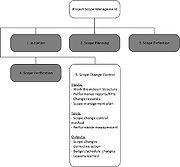Project Scope Control
Contents |
Abstract
As the project scope continuously develops, it is essential that projects have a clear scope management process, which defines how scope is to be defined, developed and managed. This is the process of monitoring the status of the project and product scope and managing changes to the scope baseline. The key benefit of this process is that it allows the scope baseline to be maintained throughout the project. This process captures changes in the project's budget and schedule. Project scope is defined as the "work required to output a project’s deliverable."[1] A Scope Change is a change in the agreed scope and goals of a project to address a need not originally defined to be part of the project. This includes processes for requesting, reviewing, approving, carrying out and controlling changes to the project's deliverables. There are three main stakeholder groups involved in scope change control. This includes, the proposer of the change, Work Package Owner (WPO) as well as the second approver, which could for example be the Project Director.[2] This article focuses on Scope Change Control, and for the sake of clarity, this method is applied to construction projects within the pharmaceutical industry.
Background on Methodology
Text
Application
limitation
References
- ↑ https://www.pmi.org/learning/featured-topics/scope Project Management Institute. Retrieved 18 September 2017.
- ↑ Meeting with Project Managers within the pharmaceutical industry.
